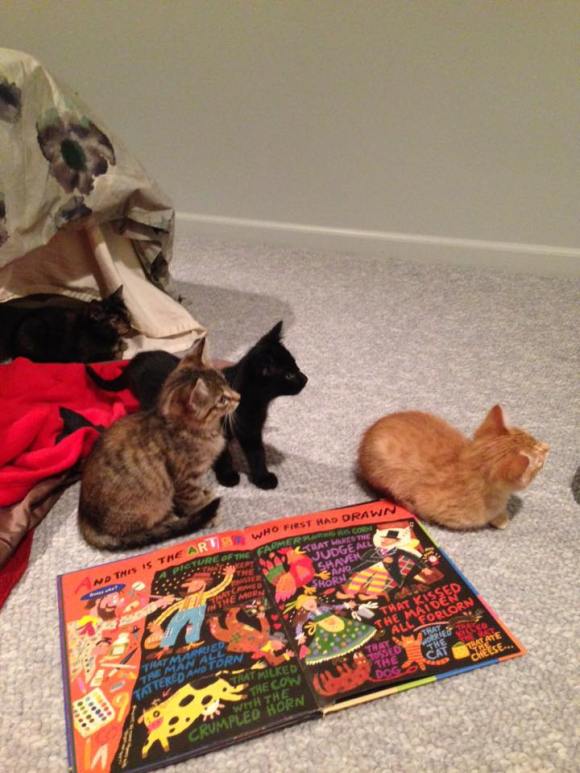Joann answered a plea on Everyblock.com about kittens born in a junkyard. The person who posted wanted to do the right thing, even though he is not partial to cats, and his wife is allergic.
Yup, there were kittens.

Five of them total, all different colors: tortie, black, orange, brown tabby, and torbie, not pictured.

These kittens were eight weeks old at the most and already weaned: the prime age for being socialized and having a chance to get off the street.
This junkyard also happened to be a few blocks away from the Joyce Division Colony, and so it’s now added to the list of our targeted TNR area. It’s a city lot filled with construction materials for the cats to hide and find shelter in, which also makes it pretty dangerous should anything be moved.

Joann started trapping the kittens right away, and of course started seeing adult cats hanging around also. This colony is behind a Kentucky Fried Chicken restaurant, which is ironically the go-to bait for trappers to use for hard-to-trap cats. So, I named this new location the KFC Colony.
The kittens were trapped quickly and crated at my place. They were pretty suspicious at first, and huddled together. They looked healthy, and came around quickly whenever we brought them food.
Introducing, from left to right, Tori, Tilly, Tigger, Tabitha and Tater.

PAWS Chicago agreed to admit these kittens into their adoption program as long as they were socialized, and put them on their vaccination schedule right away. The entire process should take about a month. We are so grateful for their help with vet care and professional guidance.
Besides care, the kittens needed daily socialization. We networked looking for a foster, and my rescue friend, Chicago TNR, found one for us, Robin T. George from Chicago TNR is absolutely selfless when it comes to rescuing cats, and I am so thankful for her friendship.
Joann has done most of the work of this rescue, including transport. She sent me the cutest text on the way to Robin’s house.

Robin and her family welcomed these kittens with open arms, and the kittens have flourished under her care. We could not have done this without her, and I am happy to have a new friend in the world of animal rescue.
The kittens are learning how to eat like house cats, each getting their own plate of food.

Playing. Obviously Tigger is the alpha male of the group.

Still all cuddling together.

But most importantly, they’re learning to love people. Robin’s daughter is reading a bedtime story here to Tilly and Tabitha, while Tigger investigates.

They don’t want her to leave.

All of the kittens had their first vet visit with PAWS, and are scheduled for admission soon. In the meantime, Tabitha started sneezing a bit, so another vet visit may be due soon. Robin is keeping a close eye on her and sent me this message, “She lets me manhandle her little kitten body, so I was able to listen to her lungs (I’m a PA) and her nose area is dry. She was purring too loud for me to hear anything! That’s assuming I could translate human medicine to cats, but my vet has the same stethoscope.” Seriously, how could you ask for a more perfect foster and scenario? She is amazing, and these kittens are on their way to their amazing new life outside of a junkyard.
 But we still have a lot of work to do. Let’s get trapping!
But we still have a lot of work to do. Let’s get trapping!





































http://www.dnainfo.com/chicago/20130221/chicago/feral-cats-spur-clash-between-audubon-anti-cruelty-societies#.UT_l9jXrGQI.mailto
Please see link, the Chicago Audubon wants TNR to become illegal in Cook County.
Also people feeding any ferals could be ticketed.
Also see http://www.catvando.org